Invented by Joel D. Wiesner, Robert B. Gaines, Shawn Bankert, KPR US LLC
Remote monitoring systems use wireless communication networks to transmit data from medical devices to healthcare providers. These devices can include blood glucose monitors, blood pressure monitors, heart rate monitors, and other medical devices. The data is transmitted in real-time, allowing healthcare providers to monitor patients? health status and intervene if necessary.
The market for remote monitoring systems is driven by several factors. One of the main drivers is the increasing prevalence of chronic diseases such as diabetes, heart disease, and respiratory diseases. These conditions require frequent monitoring, and remote monitoring systems provide a convenient and cost-effective way to do so.
Another driver of the market is the increasing adoption of wireless communication networks. With the widespread availability of 4G and 5G networks, it has become easier and more affordable to transmit data wirelessly. This has made remote monitoring systems more accessible to healthcare providers and patients alike.
The COVID-19 pandemic has also contributed to the growth of the market. With the need for social distancing and reduced hospital visits, remote monitoring systems have become an essential tool for healthcare providers to monitor patients remotely.
The market for remote monitoring systems is expected to continue to grow in the coming years. According to a report by MarketsandMarkets, the global market for remote patient monitoring is expected to reach $31.5 billion by 2025, growing at a CAGR of 19.4% from 2020 to 2025.
One of the challenges facing the market is the lack of standardization in remote monitoring systems. There are currently no industry-wide standards for remote monitoring systems, which can make it difficult for healthcare providers to choose the right system for their needs. However, efforts are underway to develop standards and guidelines for remote monitoring systems, which should help to address this challenge.
In conclusion, the market for remote monitoring systems to monitor medical devices using wireless communication networks is growing rapidly. This technology has the potential to improve patient outcomes, reduce healthcare costs, and increase access to healthcare for patients with chronic conditions. As the technology continues to evolve and standards are developed, we can expect to see even greater adoption of remote monitoring systems in healthcare.
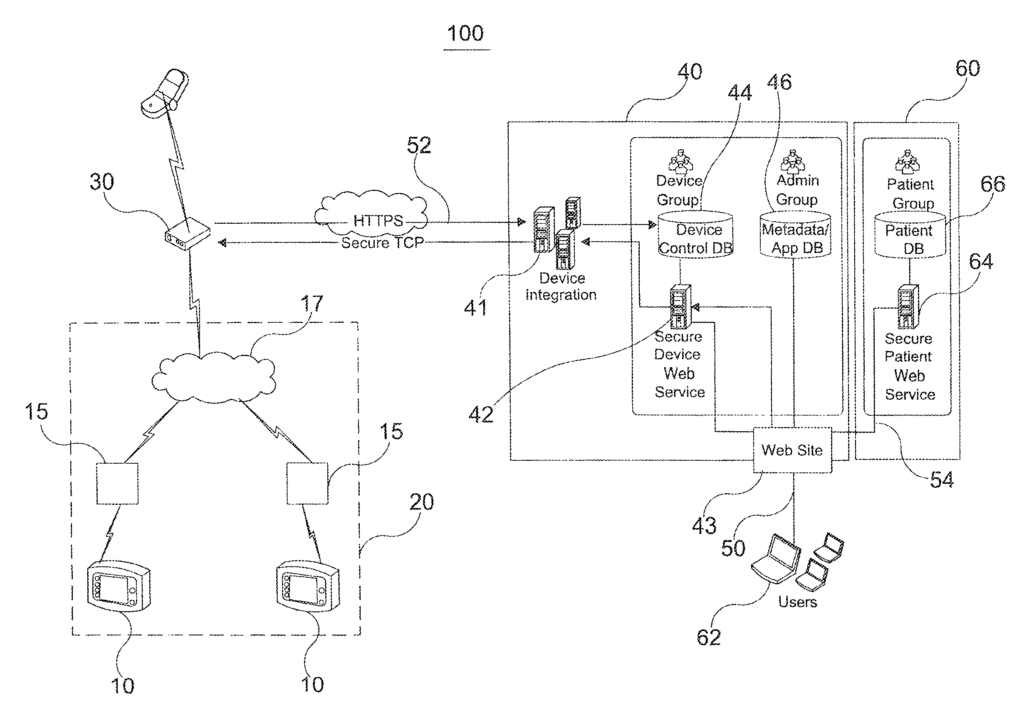
The KPR US LLC invention works as follows
Remote monitoring system that monitors a variety of medical devices in a patient’s care or at home. The system also includes a device integration servers in communication with wireless relay module for receiving data packets of medical devices, including data and identifiers. The system also contains a data management system as well as an outbound web server. The data management system logs data for medical devices. The web server can display webpages that include the data from medical devices on remote monitoring computers. However, authentication is required for the associated data request. If the user has the appropriate permissions, the Web server can look up patient information from secure sources. The device integration server can also process alert messages from wireless relay modules and transmit text message information back to wireless relay modules for relay to one or more recipients.
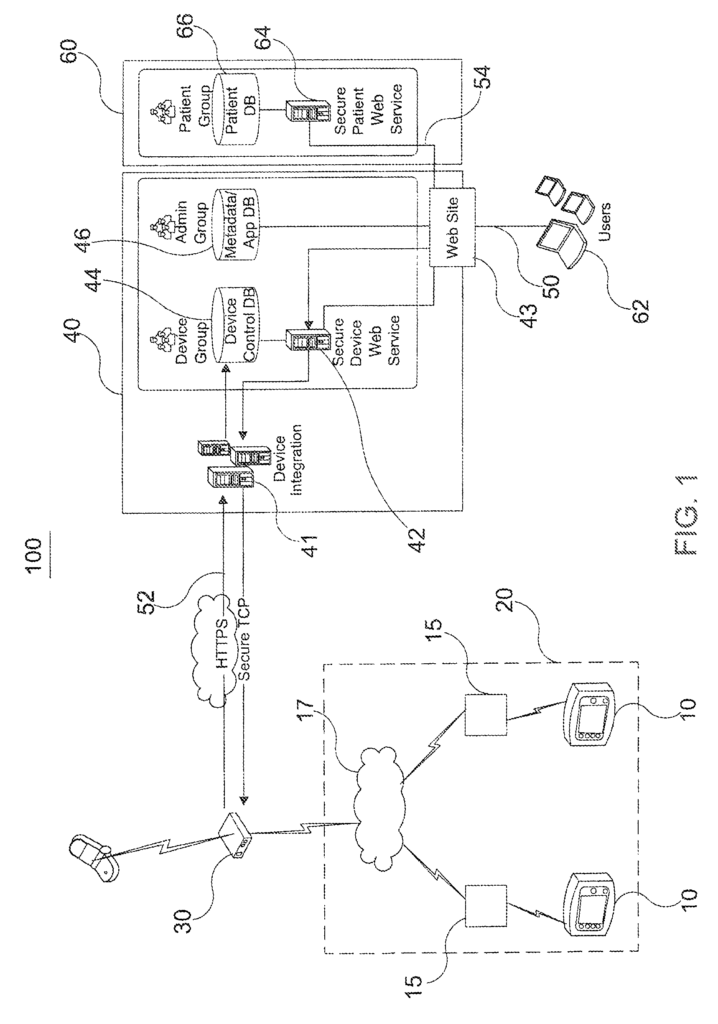
Background for Remote monitoring systems to monitor medical devices using wireless communication networks
Care giver-patient interaction is crucial in critical care and home health care centers, including hospitals, clinics and assisted living centers. Care givers must respond quickly to serious health events and conditions. To better manage patient interaction and care giver time, centralized monitoring systems were developed. These systems transmit patient’s physiological data to a central location. A single technician or a small group of technicians will monitor the patient data to determine their status. The system and technicians will communicate with local care providers to provide immediate attention to patients if they have information that indicates an alarm condition. This could be done via cell phones and wireless pagers, or by creating an audio page for the entire facility.
Implementing such centralized monitoring systems via wireless networks can present some difficulties. It would be possible to monitor patient status using information from a variety medical devices. These devices could be dynamically assigned to patients in different rooms or floors. This is why it would be beneficial to establish communication between the medical devices with the central location via a local area network, such as a Wi-Fi. IEEE 802.11 standards. These networks are often already in place in facilities to support many other functions, such as physician access to EMRs, facility administrative systems, and other functions. It is not always possible to obtain sufficient local network access for the purpose centralized monitoring. Access to WiFi networks and traditional local area networks may not be available or reliable enough to support critical care monitoring applications when the patient is far from a critical health care center.
It may be possible to have a single “off-site” location for better centralized monitoring of critical and home care service centers. centralized monitoring location for monitoring several geographically-dispersed critical care health service centers.
ZIGBEE networks, which are based on IEEE 802.15.4 standards for wireless personal area networks, have been used to collect information from various medical devices, in accordance with IEEE 11073 Device Specifications for point-of care medical device communication. These include pulse oximeters. pulse monitors. weight scales. and glucose meters. You can find the entire ZIGBEE Wireless Sensor Applications For Health, Wellness and Fitness, ZIGBEE Alliance, March 2009. It is also incorporated herein by reference in its entirety. ZIGBEE networks offer the advantage of being configurable dynamically, such as in self-healing. ZIGBEE networks can be used in mesh configurations and operate with low power requirements. This allows for the ZIGBEE transceivers, which are integrally coupled to medical devices, to work under battery power. Transmission distances between individual ZIGBEE transmitters are usually limited to a few hundred feet. These networks can be used for communications on-site with medical devices but are not suitable for remote monitoring. A hybrid system could be used in which one or several wireless personal area networks is configured to allow on-site communication between medical devices and one (or more) wireless relay modules that are further configured for communication with off-site central monitoring systems (for instance, via a wireless wide range network (WWAN), such as a mobile telephone network (such as a Global System for Mobile Communications, Code Division Multiple Access, or CDMA cellular network, or associated wireless data channels). The related patent applications titled?Wireless Relay module for Remote Monitoring Systems? describe such a relay module as well as the system. (U.S. Application Ser. No. No. (U.S. Application Ser. No. No.
In compliance with the applicable patient data privacy provisions of Health Insurance Portability and Accountability Act of 1995 (HIPAA), information between monitored medical devices and the central location must be done securely. The medical device and associated patient information must only be accessible to those who have the right access credentials. The centralized monitoring system must be able to recognize medical device information and reach those personnel on-site to notify them of the alert condition.
It would be possible to have a remote, central medical information monitoring system that communicates via a wireless network with a wide reach (e.g. a wireless wide-area network) with one or several critical care or home care service centers. The wireless relay modules relay communications from on-site medical devices using a wireless personal area network or wireless local area network. The centralized medical data monitoring system should also be capable of configuring medical devices according the patients and sites they are associated with, as well as logging communications from the devices. It should also be able to display medical device data to those who have the necessary credentials. It would also be desirable for the central information monitoring system be able to transmit information to the devices via wireless relay modules. This includes information about software updates and library upgrades.
The present invention relates to a remote monitoring device and method for monitoring status of multiple medical devices that are located far from the monitoring system at a home or patient care facility. One embodiment of the invention provides one or more medical devices at a patient or home care facility. This includes, but is not limited to, respirators, enteral feed devices, pulse oximeters pulse monitors blood pressure monitors pulse monitors, weight scales, and glucose meters. Each medical device is equipped with an interface circuit that allows it to communicate wirelessly with one of the wireless relay module via a wireless network. Further, the wireless relay modules can communicate with remote monitoring devices over an internet-accessible wireless communication networks. Preferably, this is a wireless wide area network (WWAN), such as a mobile telephone network that includes (for example) a Global System for Mobile Communications, Code Division Multiple Access (CDMA), cellular network or associated wireless channels. Secure communications are also recommended to ensure compliance with HIPAA regulations.
The remote monitoring system and its method include a device integration server that communicates with wireless relay modules to receive data packets from them, including information from medical devices. This information may include data about the medical device as well as identification of the associated medical device. It is encrypted or securely transmitted to comply with HIPAA patient privacy provisions. The information could also include encrypted or securely transmitted patient identification information. This information should be coded in its unencrypted form to avoid any reference back to the patient’s name.
The remote monitoring system includes a data management platform that includes a secure web server for devices and a device control system, as well as an outbound web server. The data management system logs information concerning medical devices that is sent to the device integration servers. The web server can display webpages containing the data from medical devices on remote monitoring computers, provided that the associated data request is authenticated.
The remote monitoring system can also be configured to secure communications with a patient data database node, which securely stores patient information. The remote monitoring computer may also be granted additional access upon sufficient requestor authentication. This allows patients to configure medical devices and to control the operation of those devices. The remote monitoring system can also be set up to receive alert messages from wireless relay modules and transmit text message information to wireless relay modules for relay to one or more recipients. The remote monitoring system can also be set up to send the text message directly from the remote monitoring station to one or more recipients of text messaging.
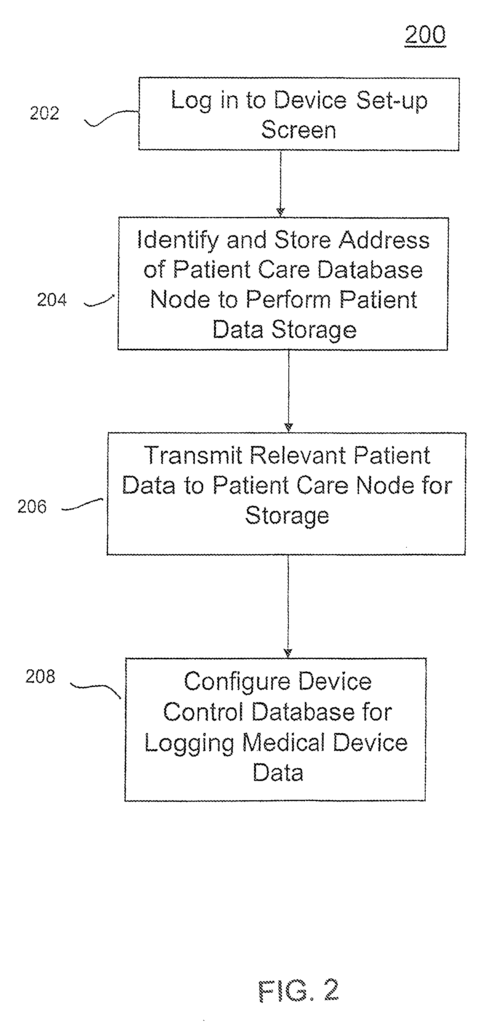
We will now refer in detail to the exemplary embodiments and the best methods of carrying out the invention. The accompanying drawings show examples of these exemplary embodiments. Although the invention is described with these embodiments in mind, it should be understood that the invention does not limit itself to those embodiments. The invention does not limit itself to the described embodiments. It is intended to include all modifications and equivalents that fall within the scope and spirit of the invention, as set forth in the appended claims.
The following description provides a detailed understanding of the invention. You can practice the present invention without any or all of these details. Other well-known aspects are not described in detail to avoid confusing the invention.
Fig. 1 illustrates the invention. 1-6.
In this specification, and the appended claims the singular forms?a? ?an,? ?an,? Unless the context requires otherwise, plural references are allowed. All technical and scientific terms are understood as they are by one of ordinary skill in art.
FIG. 1 shows a diagram of an exemplary 100-channel system for monitoring medical devices according to the present invention. 1. One or more medical devices 10, for example, are available at patient facility 20 to monitor the medical condition or administer medical treatment to one or several patients. A patient facility 20 could include a hospital, clinic, assisted living center, etc., for a variety of patients or a home facility that can be used to service one or more patients.
An interface circuit 15 is associated with each medical device 10. It includes one or more transmitters and/or receivers for transmitting and receiving signals in facility-oriented wireless networks 17 such as a Low-Rate Wireless Personal Area Networks (?LR-WPAN). ZIGBEE network and other low-power personal areas networks such as a BLUETOOTH network. These are currently in development or under consideration. Houda Labiad et. al., WiFi, Bluetooth Zigbee, Zigbee, and WiMax, Springer 2010. This is incorporated herein by reference in its entirety. Interface circuit 15 can be contained in or disposed outside of medical device 10, according to the present invention.
A number of relay modules are also included in the patient facility 20. Each relay module 30 contains a first transceiver that receives signals from and transmits them to interface circuits 15 of the facility-oriented wireless networks. It also includes a second transceiver that wirelessly transmits and receives signals from an access point 40 over a wireless wide area network (?WWAN?) 52. For use with the invention, suitable WWANs include networks that are based on a Global System for Mobile Communications or Code Division Multiple Access (CDMA) network or associated to the 2G, 3, 3G, Long Term Evolution (ITU-R) cellular wireless standards. Vijay Garg’s Wireless Communications & Networking (Morgan Kaufmann 2007), which is incorporated herein by reference in its entirety, can be found. HIPAA regulations require that communications over the facility-oriented wireless network or WWAN be conducted securely. This could include using either a Secure Sockets Layer protocol (SSL) or Transport Layer Security protocol (TLS).
As shown in FIG. “As illustrated in FIG. 41 that has access to or incorporates a transceiver capable of communicating with relay modules 30 over WWAN. The device integration server 41 receives medical device data over the WWAN and forwards it to a secure web server 42. This server is designed to log received data along with the identification information of the related medical devices in a device management database 44. A 43-bit outbound web server is used, for example to qualify requests for data retrieval from remote monitoring devices 62. The outbound web server 43 requests data from the device control server 44 via secure device web server 42. It also requests program data for building a display page using a metadata and application database 46. Finally, it requests data from a patient data database node 60 via secure link 54. 64. Secure link 54 can be used to implement a WWAN, such as an SSL protocol or TLS protocol. Separating medical device data from patient data can help to achieve economies of scale. Access point 40 can be configured to support multiple patient care facilities, each with its own secure patient database node 60. This will ensure privacy and control over the associated patient data.
In this example, a third-party service provider might host access point 40 to support multiple patient and/or homecare facilities simultaneously. This eliminates the need for each facility to maintain and configure their own access points and provides hosting services that are likely to be far cheaper than the cost of each provider configuring and maintaining access point facilities. However, access point 40 may be combined with patient care database node 60 to form a single access point. This is consistent with the principles of this invention. The outbound web server 43, as described further herein, provides an interface that authenticated clinicians can use to retrieve patient and medical information from each access point 40 and 60. It is transparent and convenient, so clinicians don’t need to know the configurations or operation of access point 40 and 60.
Returning back to FIG. 1. After retrieving the requested data from the medical device and patient, the outbound server 43 formats and transmits the data to one of the monitoring devices 62 according the retrieved program data.
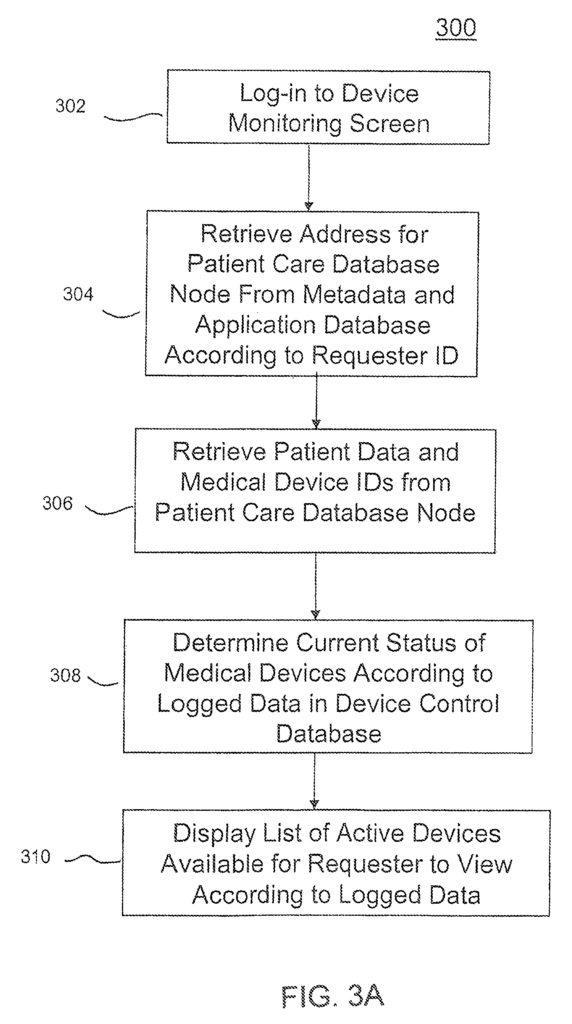
In addition, and according to further description herein, the device Integration Server 41 of FIG. 1 can transmit information and commands via WWAN to the relay modules 30. This is used, for example, to send medical device alert messages (for example to cellular telephones of emergency responders) and/or to transmit operating commands, software, or firmware updates to medical devices 10 via interface circuits 15 and the facility-oriented wireless network 17.
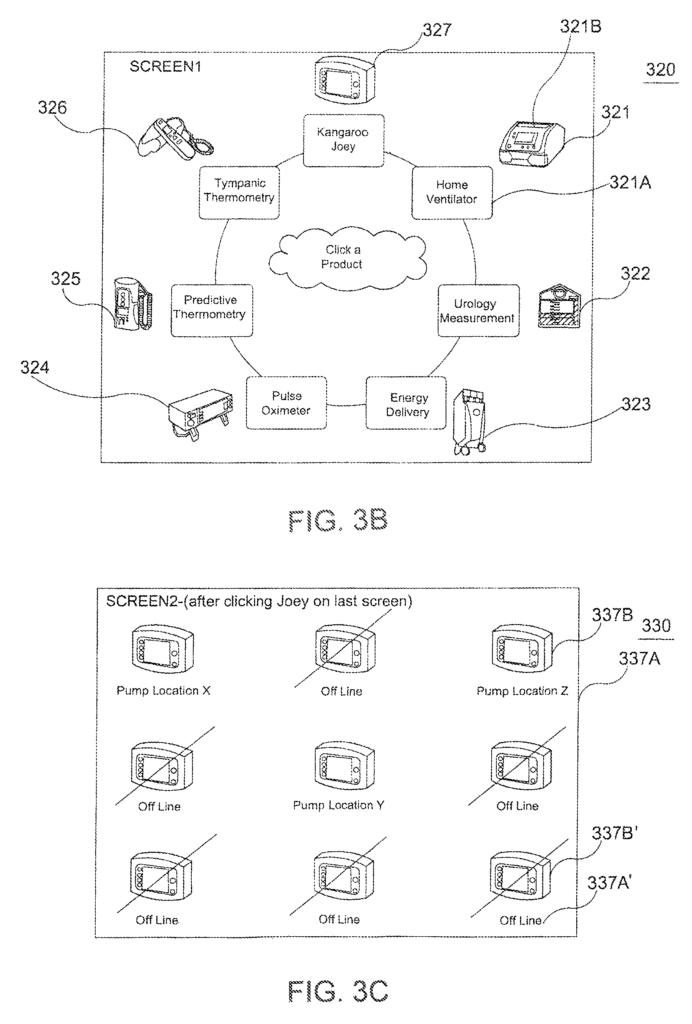
Click here to view the patent on Google Patents.
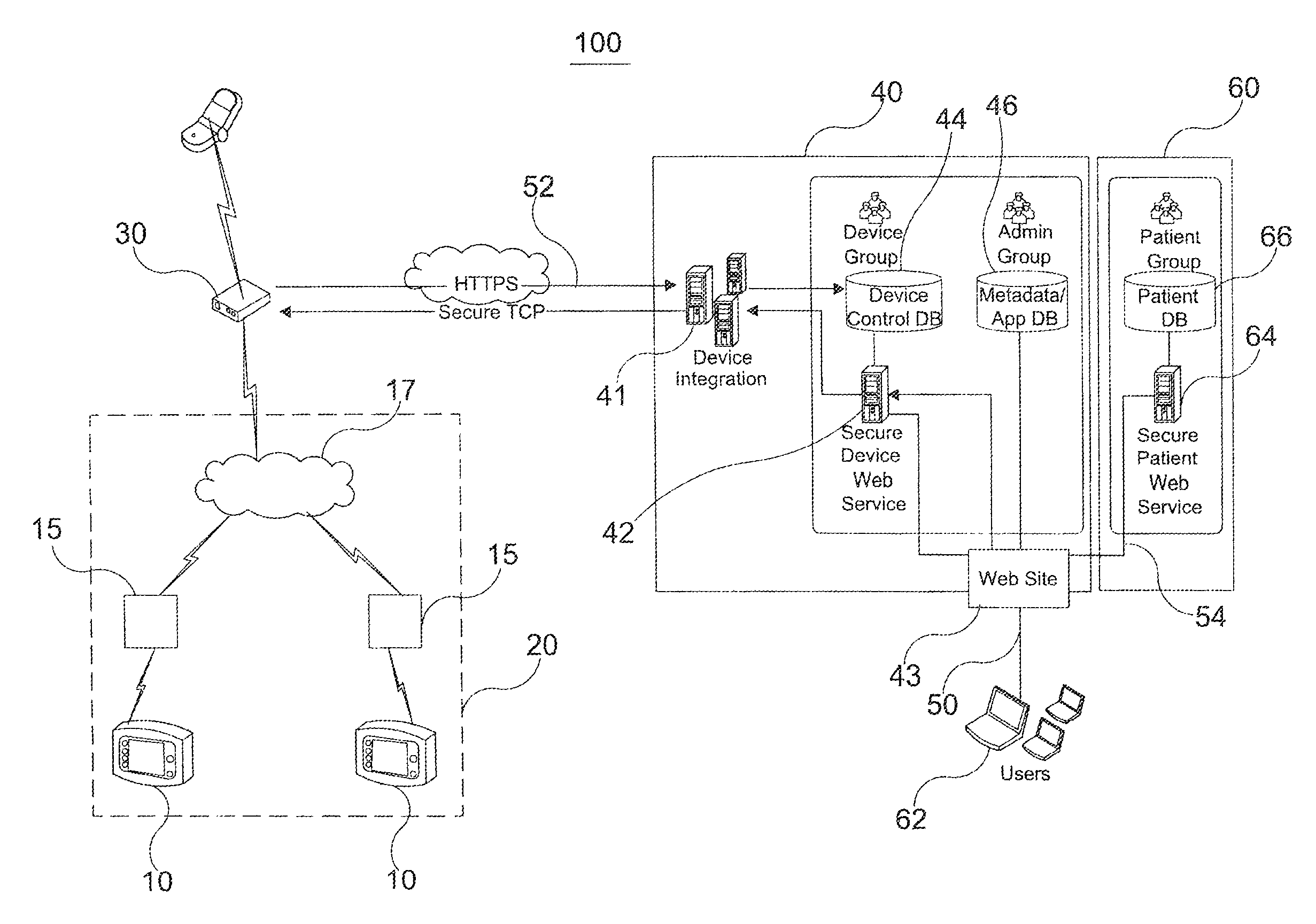
Leave a Reply